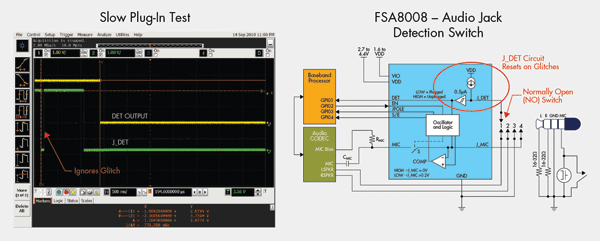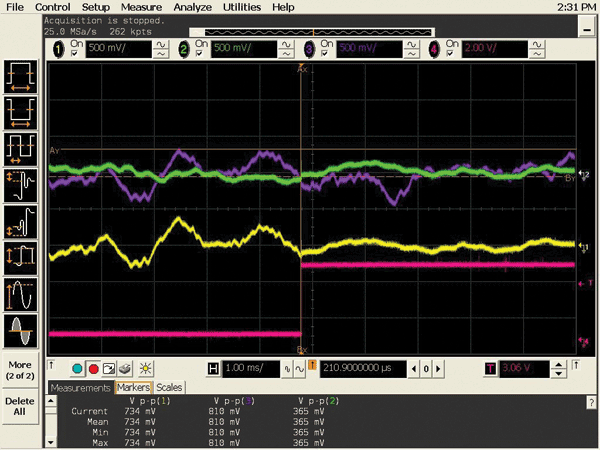Solutions for mobile audio fidelity and functionality
Dealing with issues of click-and-pop and conforming to different world standards
BY ENRIQUE O. RODRIGUEZ and SETH PRENTICE
Fairchild Semiconductor
www.fairchildsemi.com
In the mobile market, audio fidelity and functionality continue to drive new innovations for listening to music, watching movies, or placing a phone call. As a result, semiconductor suppliers have been challenged to create audio solutions that meet these requirements for audio ports and headsets. This article will describe some of the new solutions including the reduction of various types of click-and-pop and conforming to different world standards for headsets.
Over the last couple of years, headphone and headset makers such as Bose, Sennheiser, Ultimate Ears, Monster, and Harman Kardon have created new products in alliance with major smartphone manufacturers including HTC, Samsung, and Apple. The product diversity has extended past basic headphones to headsets that can help with the smartphone’s ability to receive calls, as well as regulate the volume up/down, play/pause functionality, and microphones.
Challenges
The next generation of headsets now includes active-driving devices that improve audio fidelity with various features such as noise reduction and cancellation. Smartphone manufacturers must ensure a seamless customer experience by allowing different headphones and headsets from varying vendors to work with every device. In order to meet this customer need, manufacturers work with semiconductor suppliers to aid in the adoption of these headphone accessories.
Another challenging aspect is that different smartphone models may have a completely different audio codec solution. As an example, if we look at the teardowns from iSuppli and iFixit of the Samsung Galaxy S II GT-i9100 smartphone, you will find one type of audio codec, but in the Samsung Galaxy S III you will find another. The two audio codecs differ in features including noise reduction, parametric equalization, and integrated headphone capacitors.
Although these are distinct audio codec devices, they must work with all the prior headsets at the “relative” same performance. As a result, many smartphone manufacturers have had to adopt supplementary audio jack detection devices that allow the usability of audio accessories to remain the same.
Analyze the problem further from the 3.5-mm audio jack and the attached headset perspective and it will be evident that the user needs to plug in the aftermarket or OEM headphone into the mobile device. At this point, because the headset is being plugged in, there cannot be any signal transients on the left or right connectors of the headset plug. This would result in an audible click or pop, also known as an insertion click-and-pop.
Once the headphone is attached, the phone must perform a headset detection process before it can apply the appropriate audio and control signals. The detection includes verification of a 3- or 4-pole headphone, an active or inactive headset, and GND and MIC plug polarity.
During this particular stage of detection there cannot be any audible click or pop. Once the plug has been identified, the audio codec or baseband is notified and can then apply the audio and control signals to the headphone. During operational mode, the detection scheme cannot degrade the audio fidelity.
Plug insertion and removal
When the audio plug is inserted or removed, a pop-and-click sound may be caused by the MIC bias being present while two audio amplifiers are active. This is typically caused by improper isolation timing or by gating of the biases. When the plug is inserted or removed, the terminals scrape past these biases, creating pop-and-click.
Both of these issues can be resolved by implementing a more advanced jack-detect circuit. Traditional jack-detect circuits use either a N/O (normally open) or N/C (normally closed) mechanical switch in the jack with a pullup resistor to a baseband GPIO (general-purpose input output). For example, with a N/O mechanical switch where a plug is not inserted, the logic level is high; and when the plug is inserted, a ground path is connected to the pullup resistor creating a low logic level.
To debounce this circuit a parallel capacitor is used to create an RC (resistor capacitor) circuit.

Fig. 1: Jack detection with debounce reset on glitches caused by slow/partial plug insertion.
Typically this RC debounce time is ~500 ms and this where the issue lies. A set debounce time does not provide flexibility for slow-plug insertion and the plug’s removal debounce time has the same timing as insertion. By implementing a more advanced detection circuit, such as Fairchild’s FSA8008 audio jack detector (see Fig. 1 ) and configuration switch, these issues can be resolved. This device uses a 0.5-μA pullup current source on the jack’s mechanical switch and additional logic to resolve these issues. During plug insertion the device implements debounce logic, and if at any time the jack detection logic glitches because of slow or partial insertion, the debounce time resets. This ensures that the plug is fully inserted before activating the MIC bias and amplifier.
Furthermore, the FSA8008 isolates the MIC bias with a switch to ensure there is no MIC potential on the jack until the plug is fully inserted. The plug removal time is just as critical as the insertion timing. In this case, the removal timing must be much faster than the insertion time. Through bench characterization of the jack one can determine the proper timing needed. For example, one jack we characterized required less than 100 µs before the right terminal of the plug could be connected to the GND terminal of the jack as the plug was being removed.
For additional margin, the FSA8008 implements a 30-μs removal time which allows the device to work across many jack types. When the plug is removed the jack-detect triggers and the device quickly opens the MIC switch, which isolates the MIC bias and communicates to the baseband to deactivate the audio amplifier. By implementing more advanced jack detection and gating, or isolating, the MIC bias and audio amplifier at proper times can eliminate pop-and-click from plug insertion and removal.
OMPTP vs. CTIA audio plug standards
One of the major trends in headsets today is the choice between OMTP (open mobile terminal platform) and CTIA (cellular telephone industries association) plug standards. These two standards have the third and forth terminals swapped.
To allow mobile devices to operate with either standard, crosspoint switches, such as Fairchild’s FSA8049 device, that route between MIC and GND terminals on the jack are necessary. If a slow turn-on time is not implemented, this solution can cause pop-and-click. When switching between the terminals, if the audio amplifier is still active and the ground is being routed, the amplifier will produce a current spike that produces click-and-pop to the speakers. This will cause pop-and-click. By implementing slow turn-on times (see Fig. 2 ) in the switch, or in the case of the FSA8049 crosspoint switch with adjustable turn-on times, the di/dt across the speakers can be drastically reduced, eliminating pop-and-click.

Fig.2: Cross-point switch slow turn-on time resolved pop-and-click.
When the switch is activated and it switches from source A to source B, if the signals are not matched, a transient will result in an audible click-and-pop.
There are methods around this situation, one is the proprietary SignalWise technology which allows the signals to be matched before transitioning. In Fig. 3 , we can see the source A and B again but this time the transition occurs when they are equal, this allows for no transient resulting in no click-and-pop.

Fig.3: SignalWise technology resulting in no audible transient.
As handset manufacturers continue to push their products throughout the world, we continue to see additional features added to the 3.5-mm jack. The jacks have to recognize and adapt to all of the various standard accessories that are sold in order to have a consistent user experience. Semiconductor suppliers have created solutions to deal with issues such as click-and-pop in order to maintain the audio fidelity. ■
Advertisement
Learn more about Fairchild Semiconductor





